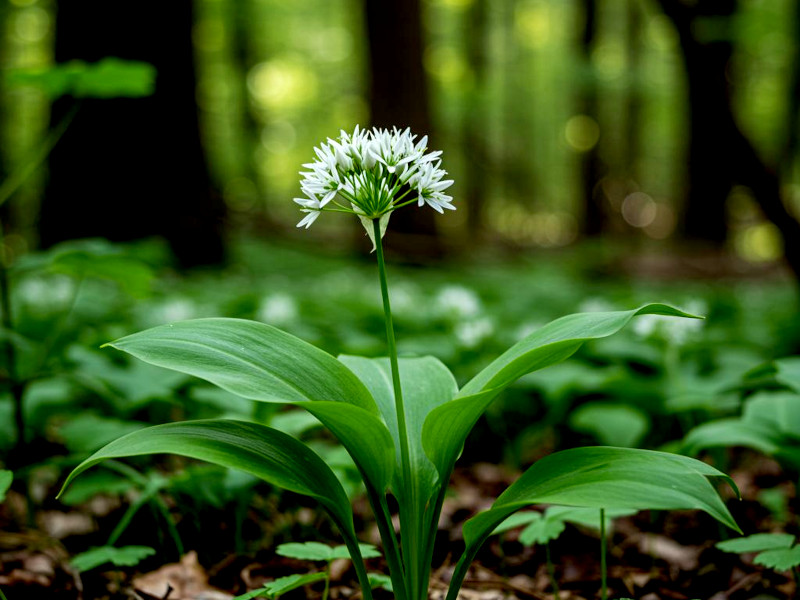Wise Mind Herbs
Evidence-based Herbal Healing
The information on this page has been prepared with reference to published scientific literature, not by a medically qualified expert. It is not medical advice. Any decision to use a supplement or herb-based product is your responsibility. Consult a suitably qualified medical professional, especially if you have underlying conditions. Remember, nothing is for everyone, and not everything sold is what it claims to be. Some things work for some people, some of the time.
Wild Garlic
Wild garlic (Allium ursinum) is a perennial flowering plant belonging to the Amaryllidaceae family. It is known by several common names including ramsons, buckrams, broad-leaved garlic, wood garlic, bear's garlic, and bear leek. It should not be confused with other Allium species such as Allium vineale (crow garlic), Allium tricoccum (North American ramps), or Allium canadense (meadow garlic), which are sometimes erroneously marketed as wild garlic.

Chemical Composition and Bioactive Compounds
Wild garlic contains various bioactive compounds including sulfur-containing compounds (allicin, alliin, ajones), flavonoids, phenolic acids, vitamins (C and E), and minerals. The characteristic odor and many of the medicinal properties are attributed to the organosulfur compounds that are released when the plant tissue is damaged. These compounds, particularly allicin, demonstrate various biological activities including antimicrobial, antioxidant, and cardioprotective effects.
Evidence-Based Health Benefits
Scientific research on Allium ursinum, while growing, remains less extensive than studies on common garlic (Allium sativum). The following health benefits are supported by peer-reviewed literature, though many require further clinical validation:
- Cardiovascular health: Studies suggest wild garlic may help reduce blood pressure, total cholesterol, and LDL cholesterol levels, while increasing HDL cholesterol.
- Antioxidant activity: Rich in compounds that neutralize free radicals and reduce oxidative stress.
- Antimicrobial properties: Shows activity against various bacteria including Staphylococcus aureus, Escherichia coli, and some antibiotic-resistant strains.
- Anti-inflammatory effects: May help reduce chronic inflammation markers.
- Digestive health: Traditional use for improving digestive function has some scientific support.
Conditions with Some Evidence for Benefit
It is important to note that wild garlic has not been definitively proven to "cure" any medical condition in human clinical trials. Evidence suggests potential benefits for:
- Hypertension: Moderate evidence for blood pressure reduction.
- Hyperlipidemia: May help reduce total cholesterol and LDL levels.
- Atherosclerosis: Preliminary evidence suggests potential for reducing plaque formation.
- Minor bacterial infections: Topical applications may have antimicrobial effects.
- Digestive disorders: May help with bloating, gas, and general digestive discomfort.
Recommended Dosages
Clinical standardization of wild garlic dosages is not well established, unlike common garlic. Available research suggests:
- Fresh leaves: 2-5g daily (roughly 1-2 medium-sized leaves)
- Dried leaf powder: 300-1200mg daily
- Tincture (1:5 in 45% alcohol): 2-4ml, three times daily
- Standardized extract (typically standardized to allicin content): 100-300mg daily
These dosages are based primarily on traditional use and limited clinical data. Active compound standardization is inconsistent across preparations, with allicin content being the most commonly measured biomarker (typically 0.2-0.5% in dried preparations).
Side Effects and Disbenefits
Though generally recognized as safe when consumed in food amounts, potential adverse effects include:
- Gastrointestinal discomfort: Bloating, flatulence, heartburn, or nausea in sensitive individuals
- Anticoagulant effects: May increase bleeding risk when combined with blood-thinning medications
- Allergic reactions: Particularly in individuals with known allergy to plants in the Amaryllidaceae family
- Breath and body odor: Similar to common garlic but potentially milder
- Pregnancy concerns: Insufficient safety data for medicinal doses during pregnancy and lactation
- Mistaken identity: Risk of confusion with lily-of-the-valley (Convallaria majalis) or autumn crocus (Colchicum autumnale), which are toxic look-alikes
Higher Dosage Studies
There is a significant knowledge gap regarding higher doses of wild garlic. No comprehensive clinical trials have systematically investigated doses above the ranges mentioned earlier. Theoretical concerns with higher doses include increased anticoagulant effects, stronger gastrointestinal disturbances, and potential interactions with medications. This represents a substantial research gap in the scientific literature.
Commercial Pharmaceutical Products
Unlike common garlic (Allium sativum), wild garlic has fewer dedicated pharmaceutical products. Most commercial products containing wild garlic are classified as supplements rather than pharmaceuticals.
Research Limitations and Knowledge Gaps
Significant research limitations regarding wild garlic include:
- Lack of large-scale clinical trials in humans
- Inconsistent standardization of products and extracts
- Limited investigation into optimal dosing regimens
- Insufficient research on specific populations (elderly, pediatric, pregnant women)
- Minimal research on long-term safety and efficacy
- Few direct comparisons with Allium sativum (common garlic)
References
Feknous, N., Boumendjel, M., & Leblab, F. Z. (2024). Updated Insights on the Antimicrobial Activities of Allium Genus (A Review). Russian Journal of Bioorganic Chemistry, 50(3), 806-823.
Filipčev, B., Kojić, J., Miljanić, J., Šimurina, O., Stupar, A., Škrobot, D., ... & Pojić, M. (2023). Wild garlic (Allium ursinum) preparations in the design of novel functional pasta. Foods, 12(24), 4376.
Najeebullah, S., Shinwari, Z. K., Jan, S. A., Khan, I., & Ali, M. (2021). Ethno medicinal and phytochemical properties of genus Allium: A review of recent advances. Pak. J. Bot, 53(1), 135-144.
Oravetz, K., Diaconeasa, Z., Carpa, R., Rakosy-Tican, E., & Cruceriu, D. (2024). The Antioxidant, Antimicrobial, and Antitumor Proprieties of Flavonol-Rich Extracts from Allium ursinum (Wild Garlic) Leaves: A Comparison of Conventional Maceration and Ultrasound-Assisted Extraction Techniques. International Journal of Molecular Sciences, 25(23), 12799.
Śmiecińska, K., Gugołek, A., & Kowalska, D. (2022). Effects of garlic (Allium sativum L.) and ramsons (Allium ursinum L.) on lipid oxidation and the microbiological quality, physicochemical properties and sensory attributes of rabbit meat burgers. Animals, 12(15), 1905.